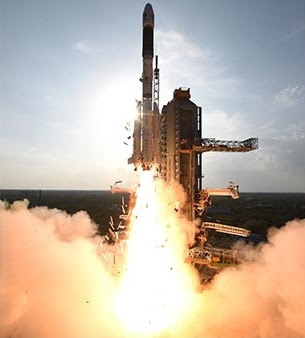GSLV-F09 launches 2230 kg South Asia Satellite GSAT-9 into a Geosynchronous Transfer Orbit (GTO). GSLV-F09 mission is the eleventh flight of India’s Geosynchronous Satellite Launch Vehicle (GSLV) and its fourth consecutive flight with the indigenous Cryogenic Upper Stage (CUS). The vehicle is designed to inject 2 - 2.5 ton class of satellites into GTO. The overall length of GSLV-F09 is 49.1 m.
South Asia Satellite GSAT-9 is a Geostationary Communication satellite realised by India. The primary objective of GSAT-9 is to provide various communication applications in Ku-band with coverage over South Asian countries.
GSAT-9 is configured around the ISRO’s standard I-2K bus. With lift off mass of 2230 kg the main structure of the satellite is cuboid in shape built around a central cylinder. GSAT-9 carries communication transponders operating in Ku-band.
The two solar arrays of GSAT-9 consisting of Ultra Triple Junction solar cells generate about 3500 Watts of electrical power. Sun and Earth sensors as well as gyroscopes provide orientation reference for the satellite. The Attitude and Orbit Control System (AOCS) of the satellite maintains it’s orientation with the help of momentum wheels, magnetic torquers and thrusters. The satellite’s propulsion system consists of a Liquid Apogee Motor (LAM) and chemical thrusters using liquid propellants for initial orbit raising and station keeping. The satellite also carries plasma thrusters, assisting in station keeping.
Launch Mass: 2230 kg
Mission Life:12 years
Power: 3500 Watts
Launch Vehicle: GSLV-F09 / GSAT-9
Type of Satellite: Communication
Manufacturer: ISRO
Application: Communication
Orbit Type: GSO
payloads: Ku-band Transponders







No comments:
Post a Comment